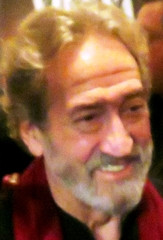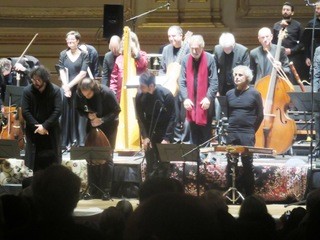|
Back
Fanfares for a Month of Venice New York
Isaac Stern Auditorium, Carnegie Hall
02/03/2017 -
“The Millenarian Venice: Gateway to The East; A Crossroad Between the Orient and Europe”
Part One: 770-1515
Anonymous: Calling of the Bells and Fanfare
St. John of Damascus: Alleluia
Byzantine Secular Ballad: Erotokritos
Macabru: Pax in nomine Domini!
Traditional: Dance of the Soul from the North African Berber Ritual
Anonymous: Ton Dhespotin, from the Sunday Service of Orthros
Traditional: Armenian Song and Dance
Conductus: O totius Asie gloria
Kalophonic Irmoid: Pasan tin elpida mou
Italian secular: Chiave, chiave
Ottoman March: Nikris
Guillaume Dufay: O très piteulx/Omnes amici eius
Lament of the Holy Mother Church of Constantinople
Clément Janequin: Escoutez tous gentilz (The Battle of Marignan; The War)
Part Two: 1526-1797
Salamone Rossi: Al naharot bavel from Hashirim asher lish’lomo
Adrian Willaert: Vecchie letrose, non valete niente
Johanis Kladás: Yefvsasthe kai idhete from the Holy Eucharist
Ambrosius Lobwasser: Ficht wieder meine Anfechter (Psalm 35) from Der Psalter... in deutsche reyme (arr. Claude Goudimel)
Persian Dance: Laïl Djân
Claudio Monteverdi: Il combattimento di Tancredi e Clorinda
Antonio Vivaldi: Di queste selve venite, o Numi from La Senna festeggiante, RV 693
Wolfgang Amadeus Mozart: Rondo alla turca from Piano Sonata in A Major, K. 331 (arr. Savall)
Petros Byzantios: Kratemata
François Marchant: Nous sommes tous égaux from La Constitution française en chanson
Gondolier Songs: Per quel bel viso & Mia cara Anzoletta from A second set of Venetian Ballads for the German Flute, Violin or Harpsichord compos’d by Sigr Hasse and all the Celebrated Italian Masters (arr. Savall)
Luigi Bordèse: La Sainte Ligue after Beethoven’s Symphonies No. 7 & No. 5 from L’Orphéon classique populaire, fragments des chefs-d’œuvre des grands maîtres (arr. Savall)
Yurdal Tokcan (Oud), Dimitri Psonis (Santur and Morisca), Hakan Güngör (Kamun), Haïg Sarkououmdjian (Duduk and Belul)
Musicians from Orthodox Byzantine Vocal Ensemble; La Capella Reial de Catalunyua; Hespèrion XXI; Le Concert des Nations; Jordi Savall (Gambist, treble viol, conductor, musical director)

J. Savall (© Samuel T. Dog)
“When I seek another word for ‘music’, I never find any other word than ‘Venice’.”
Friedrich Nietzsche br />
“She was never loved. She was always the outsider, always envied, always suspected, always feared. She fitted into no convenient category of nations. She was the lion who walked by herself.”
James Morris, Venice
My neighbor at Carnegie Hall last night pitched his voice just high enough to overcome the applause at the end of the concert and asked his wife, “So instead of those political idiots, why the hell don’t they give the Nobel Peace Prize to Jordi Savall?”
The comment was anything but facetious. And I would be the first to agree. True, I have heard this icon of musical time and space play boring concerts: a viol or two does not make for an evening’s excitement. But when Mr. Savall brings together ensembles from the world of the Mediterranean, East and West, ancient and (near) modern, as he did last night, the result is overwhelming. Both in ideas and in music.
This was the opening event of a month to celebrate the glories of “Venice the Serene”. Not the Venice of Thomas Mann or canals or tourists. But Venice which ruled the mercantile waves (Shakespeare celebrated her with two plays), Venice sent Marco Polo to explore the East, and it made Claudio Monteverdi a happy man (he was tired of composing for Dukes and Nobles, and preferred the Venetian Theaters).
And yes, James Morris’ Venice. Not a nation, not a nation-state, but a series of uninhabitable islands whose sole purpose was exploitation. She didn’t join the Crusades (but did lease out ships at exorbitant rates). Her Jewish ghetto was only tolerant of Jews because they could finance great dealings (see Merchant of Venice). And her democracy of Doges was only so these rich nobles could erect the outlandish architecture, owing all to Islam and Catholicism and Judaism and the Byzantine Church.
Venice has always been an event. And Carnegie Hall’s tribute to Venice this month–like the city to its islands–extends to institutions around Manhattan. Yet no event could surpass that of Jordi Savall. He embraced Venice’s own international tentacles with nearly all the musical groups he has made his own.

The Ensembles (© Samuel T. Dog)
From Byzantine Constantinople came four singers with the Orthodox musical canon. From Armenia came instrumentalists. From the Spanish chapel came six singers, including a counter-tenor. From Mr. Savall’s own Hespèrion XXI was an ensemble of 11 artists playing rarities like the cornamuse, the Jewish shofar, the shawm, the sackbut, the anafil (the long long Medieval trumpet-trombone), all the viells and viols. And from The Concerts of Nations, seven players of more “modern” instruments like strings, harpsichords, with percussion and bells.
The question as this huge ensemble made its way on stage was: How could even a Jordi Savall bring these such a variegated ensemble together?
He performed this balancing act in two ways. One was historical. Between each of the 30-odd pieces of music, ranging from the Eighth to 19th centuries, the screen gave truncated piece of history, showing Venice in all its guises. The Catholic Church, a homeland for Jews and Armenians and Byzantines, the trader with the Eastern Orthodox Church, and a secular society.
All of this illustrated by music, the musicians themselves in divergent groups. For me, it was Part One, from 770 to 1515. Most of the music evolved. But the singing from the four men of the Orthodox Byzantine Vocal Ensemble has changed not at all. Their half-dozen hymns were like a foundation to the concert, an immutable history.
Against this was a wide variety. St. John of Damascus had always lived under Muslim rule, but managed to pen a thousand documents and hymns, one of them the Alleluia, a simple melody above the organum. As Mr. Savall continued through the Crusades, we heard a triumphant march by the 10th Century troubadour Marcabru (a good place to blaze out with those anafils!)
As Constatinople fell to the Seljuk Turks, Mr. Savall continued with an Armenian song, a dismal prayer during the Black Plague, a joyous Italian street song and a scary Ottoman march. (Rather, the Turks wanted their military music to sound scary, and the peasant-armies of Europe usually scattered). It ended with a hymn by Dufay–and a war song by my own favorite, Clément Janequin.
Before Rameau and 400 years before Richard Strauss, Janequin invented the “symphonic poem, depicting hunts, battles birds, for voices and illustrative instruments. He left virtually no church music, and that was fitting here, for Part Two would mainly be devoted to the soon-to-be scientific and secular world.
Here was had a rare piece by Salamone Rossi, the Jewish composer who extolled a reading from “the waters of Babylon”, very affective. And here were more Greek chants, a boring Lutheran hymn. Only Bach could translate Lutheran music into something approaching godly music.)
The standout work was Monteverdi’s Combat between Tancredi and Clorinda, a piece of early feminism, of chivalry and extraordinary musical pictures, with Tancredi himself the wonderful bass Daniele Carnvich.
Now came some true magic. Mr. Savall arranged Mozart’s Rondo alla turca for strings–and a whole Turkish military ensemble. And one knows that Wolfgang would have jumped up with excitement. Mr. Savall also arranged two gondolier songs (yes, Venice was being discovered by the likes of Byron and Shelley).
No concert like this is perfect, and the choral arrangements from Beethoven’s Seventh (the second movement) and the military chorale from the finale of the Fifth were both jingoistic, kitschy and...er...kinda silly.
Mr. Savall finished though, with a composite music from Dona nobis pacem, beginning with a kind of alto flute, continuing with the entire ensemble. A stunning finish, an eclectic sound which embraced all those times and spaces which Mr. Savall has called his own.
This was, yes, a Venetian world. But it was the Mediterranean Sea, Occident and Orient. And if this is less a review than a celebration, so be it. And amen to all that. And to Jordi Savall’s panoply from history.
Harry Rolnick
|